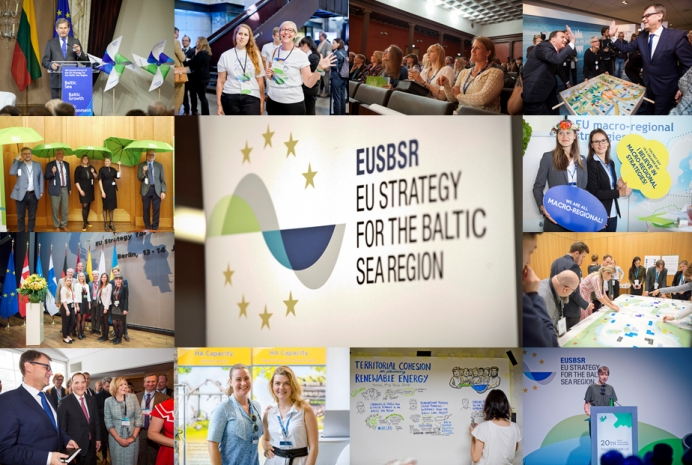The whole process took several years before the Strategy was approved and many people from all BSR countries and institutions were involved in the creation of the Strategy resulting in a historical event in 2009 – the Strategy was approved by the European Council following a communication from the European Commission. The idea of the EUSBSR was mainly focused on fostering the economic growth and better utilisation of the potential in the Baltic Sea region with three major pillars (1) saving the sea, (2) connecting the region, and (3) enhancing prosperity.
"The strategy is a well-coordinated and time-tested mechanism that works as long as there is motivation and consensus"
We had an honour to talk to Mrs. Natalija Kazlauskienė, who was the director of Directorate-General Regional Policy, Directorate for Policy development and coordination, back in 2009 when the Strategy was adopted. Mrs. Kazlauskienė was deeply involved in the development and the assessment process of the Strategy and has long expertise in regional development. Currently she works as Principal Adviser (EC Directorate-General for Regional and Urban Policy), seconded in the interest of service to Lithuanian Government.
Regarding the effectiveness of the Strategy and its ten years of operation, Mrs. Natalija Kazlauskienė emphasized, “The strategy is a well-coordinated and time-tested mechanism that works as long as there is motivation and consensus among the states in the Baltic Sea Region. For this reason, it can be said that the strategy will continue as a joint effort as long as there is a recognised need for cooperation.” According to EU Commission reports, the strategy is considered a showcase in matters of awareness-raising in policy making. “The future and further direction of the strategy depend entirely on the will and consensus of the countries,”Mrs. Kazlauskienė adds.
Worth to mention, that EUSBSR implementation is coordinated in close contact with the European Commission and all relevant stakeholders, i.e. other member states, regional and local authorities, inter-governmental and non-governmental bodies. The Strategy is also welcoming cooperation with EU neighbouring countries (Russia, Iceland, Norway and Belarus) where and as appropriate.[1]
When it comes to achieving the goals of any strategy, the financial mechanisms are often considered to be necessary. However, there is no dedicated financial source or instrument for strategy implementation.. “The Strategy is a very good example of how regional cooperation can operate without establishment of a special dedicated financing mechanism , how promotion of synergies and common agreement between Baltic Sea Region countries can be reached to address the most pressing challenges, not just focusing on the absorption the EU or any other funds, but to solve common problem and address common development challenges via enchanced cooperation” – Mrs. Kazlauskienė explains.
Today, EUSBSR is implemented through joint projects (flagships) creatively using existing funding sources, which can be seen as more coordinated and more effective approach to strategy implementation.
There is no doubt that similar goals and aspirations and regional cooperation is beneficial in variety of ways
It contributes to economic strengthening, improved connectivity, environmental sustainability, political stability, etc. Shared resources, expertise and common goals help countries bordering the Baltic Sea to meet common challenges and cope with them using joint forces. Theoretically, a region is an area that is differentiated from other area according to certain criteria.
However, Baltic Sea Region is more than simple geographic region. Fouberg, Murphy, and de Blij’s book “Human geography“ defines a term “functional region“ by a set of activities or interactions that occur within the region. Mrs. Kazlauskienė emphasises, that “the Baltic Sea Region historically is one of the first working functional area in Europe, which is definitely linked by history, culture, geography and common identity”.
In today’s world, the biggest challenges have no territorial boundaries – for example, climate change or Baltic Sea pollution do affect entire region, not one country or particular area within it – thus problem-solving cannot be confined separately. “Keeping in mind current global and regional challenges, the focus in multi-dimensional problem-solving practice should be on functional areas or regions rather than limited and fragmented by the national or administrative borders”, Mrs. Kazlauskienė suggests. In these terms, EUSBSR as a strategy helps to coordinate effective regional cooperation that leads to successful outcomes.
First decade has proved that EUSBSR, being the first macro-regional strategy, is capable to overcome obstacles
Finally, celebrating the 10th anniversary of EUSBSR one could only wish to continue strengthening cooperation in different areas and on various levels, keep high motivation and enthusiasm, and join forces and resources to address future challenges. Because together we can do more and better!
[1] “EUSBSR in a nutshell” < https://www.balticsea-region-strategy.eu/about/about>




